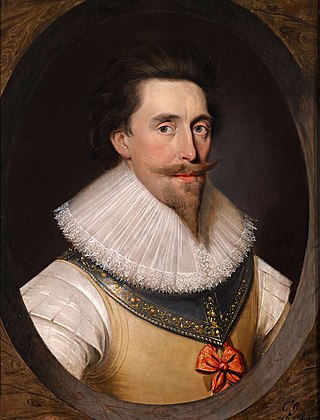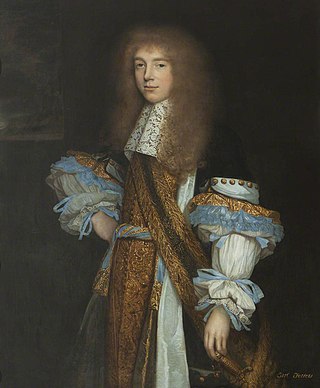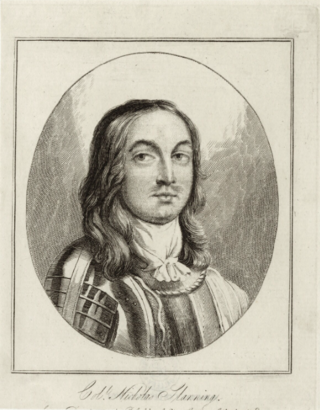
Sir John Gell, 1st Baronet was an English landowner from Derbyshire, who acted as local Parliamentarian commander for most of the First English Civil War before resigning in May 1646. He was notorious for parading the body of his Royalist opponent through Derby after the Battle of Hopton Heath in March 1643.
Philip Stanhope was Colonel of the Shelford Manor Royalist forces in the English Civil War. He was the 10th son of Philip Stanhope, 1st Earl of Chesterfield (1584-1656) and his wife Catherine, daughter of Francis Hastings, Baron Hastings.

Philip Stanhope, 1st Earl of Chesterfield was an English nobleman, aristocrat and royalist, who was created the first Earl of Chesterfield by King Charles I in 1628.

Sir Richard Browne was a merchant and MP from London who became a Major general in the Parliamentarian army during the Wars of the Three Kingdoms. A moderate Presbyterian, after victory in the First English Civil War Browne supported a negotiated settlement in which Charles I retained his throne. As a result, he fell out with radicals such as Oliver Cromwell, and was excluded from Parliament by Pride's Purge in December 1648.

Francis Fane, 1st Earl of Westmorland, of Mereworth in Kent and of Apethorpe in Northamptonshire was an English landowner and politician who sat in the House of Commons between 1601 and 1624 and then was raised to the Peerage as Earl of Westmorland.

Shelford Priory is a former Augustinian Monastery located in the village of Shelford, Nottinghamshire, United Kingdom. The priory was founded by Ralph Haunselyn around 1160–80 and dissolved in 1536. Little remains of the original priory. Following dissolution it was granted to Michael Stanhope, and c.1600 Shelford Manor was constructed on the site. The manor was fortified and then partially destroyed during the English Civil War. The house was reconstructed c.1678, however, it was altered in the 18th and 19th centuries. It is now known as Shelford Manor and is a private residence.

Sir Thomas Aston, 1st Baronet was an English politician who sat in the House of Commons in 1640. He fought for the Royalist cause in the English Civil War. The portrait he commissioned from John Souch of his first wife Lady Magdalene Aston on her deathbed is in Manchester Art Gallery. He is known as an apologist for the Church of England.
Henry Stanhope, Lord Stanhope KB, known as Sir Henry Stanhope until 1628, was an English nobleman and politician.
Arthur Stanhope was an English politician who sat in the House of Commons between 1660 and 1679.

Robert Shirley, 1st Earl Ferrers PC —known as Sir Robert Shirley, 7th Baronet, from 1669 to 1677 and Robert Shirley, 14th Baron Ferrers of Chartley, from 1677 to 1711—was an English peer and courtier.

Sir Nicholas Slanning was a soldier and landowner from Devon who sat in the House of Commons from 1640 to 1642. He served in the Royalist army during the First English Civil War and was mortally wounded at Bristol on 26 July 1643.

Sir John Port was an English landowner and Knight of the Order of the Bath who served occasionally in the House of Commons. He was High Sheriff of Derbyshire in 1554. By his will, he founded Repton School and almshouses at Etwall. He also owned Caverswall Castle from 1531 after acquiring it through marriage to Elizabeth.
Francis Hastings, Lord Hastings was the son of George Hastings, 4th Earl of Huntingdon and Dorothy Port. He married Sarah Harington, daughter of Sir James Harington and Lucy Sydney. They had five children:

John Arundell of Trerice (1613–1644) was a landowner from Cornwall who sat in the House of Commons from 1640 to 1644. He supported the Royalist cause during the First English Civil War and was killed during the Siege of Plymouth in November 1644.
Sir John Hotham the younger, known as Captain Hotham, was an English member of parliament and military commander who fought for the Parliamentarians during the First English Civil War. He was executed for treason in 1645.

Guilford Slingsby (1610–1643) was a member of the Yorkshire gentry who was confidential secretary to Thomas Wentworth, 1st Earl of Strafford, and present during the trial which ended in his execution in April 1641.

The Battle of Burton Bridge was fought between Royalist and Parliamentarian forces at Burton upon Trent on 4 July 1643 during the First English Civil War. By the time of the battle, the town, which had at various times been held by both sides, was garrisoned by a Parliamentarian unit under the command of Captain Thomas Sanders and the town's military governor, Colonel Richard Houghton. The key river crossing at Burton was desired by Queen Henrietta Maria, who was proceeding southwards from Yorkshire with a convoy of supplies destined for King Charles I at Oxford. The Royalists, led by Colonel Thomas Tyldesley, launched a cavalry charge across the bridge which succeeded in defeating the Parliamentarians and capturing most of their officers, including Sanders and Houghton. The Queen's convoy proceeded on its way south to Oxford, with Tyldesley receiving a knighthood and a promotion in recognition of his victory. Burton changed hands several more times during the course of the war, before finally coming under Parliamentarian control in 1646.
Sir Edward Rodney was an English politician who sat in the House of Commons at various times between 1621 and 1642.
The Kent Trained Bands were a part-time military force recruited from Kent in South East England, organised from earlier levies in 1572. They were periodically embodied for home defence and internal security, including the Spanish Armada campaign in 1588, and saw active service during the Wars of the Three Kingdoms. They were replaced by the Militia in 1662.
The Somerset Trained Bands were a part-time military force in the county of Somerset in South West England from 1558 until they were reconstituted as the Somerset Militia in 1662. They were periodically embodied for home defence, for example in the army mustered at Tilbury during the Armada Campaign of 1588. They fought of the Battle of Newburn in the Second Bishops' War and their units saw considerable active service for both sides during the English Civil War.












